Theories and Principles of Learning
VerifiedAdded on 2021/02/19
|10
|3696
|63
AI Summary
Contribute Materials
Your contribution can guide someone’s learning journey. Share your
documents today.
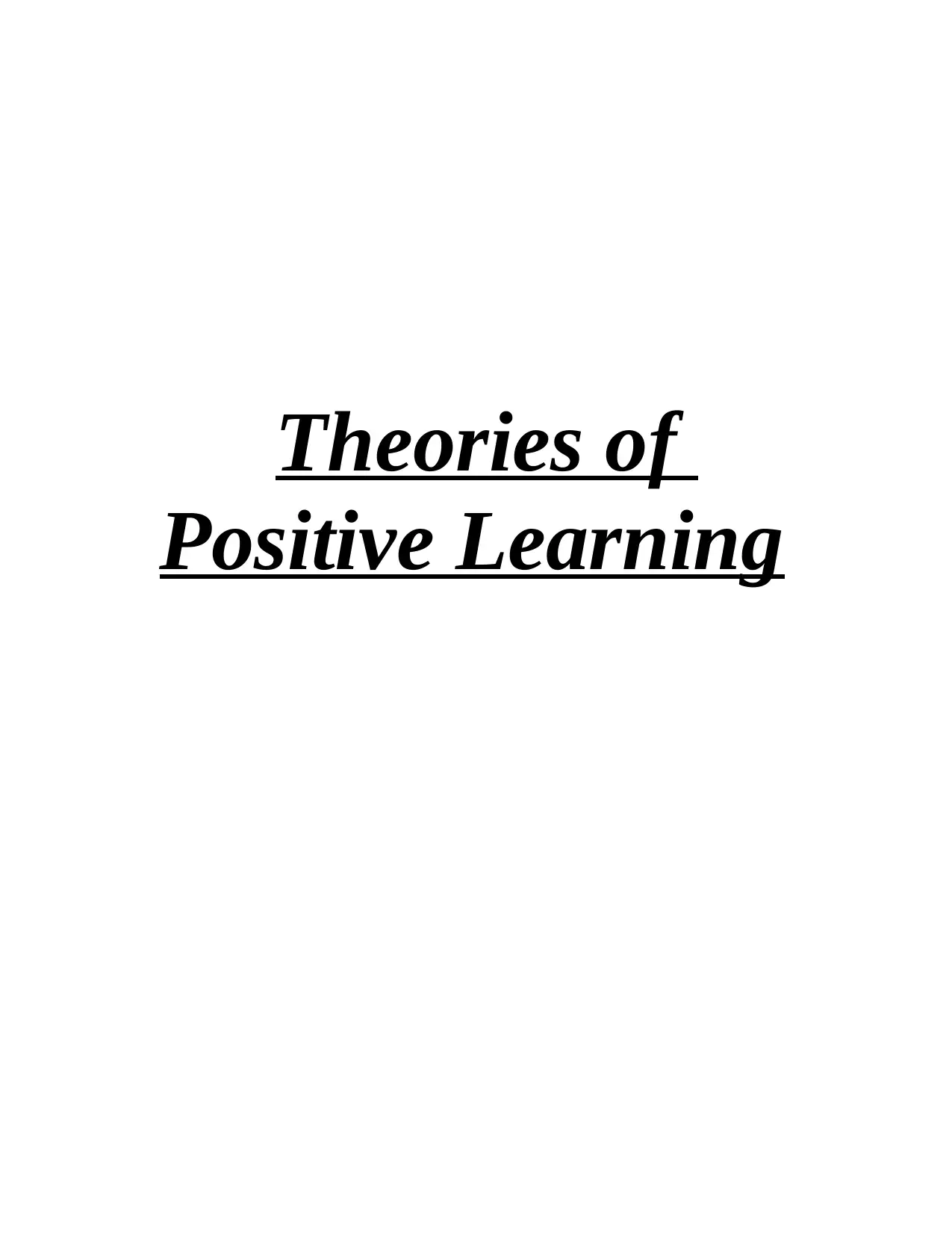
Theories of
Positive Learning
Positive Learning
Secure Best Marks with AI Grader
Need help grading? Try our AI Grader for instant feedback on your assignments.
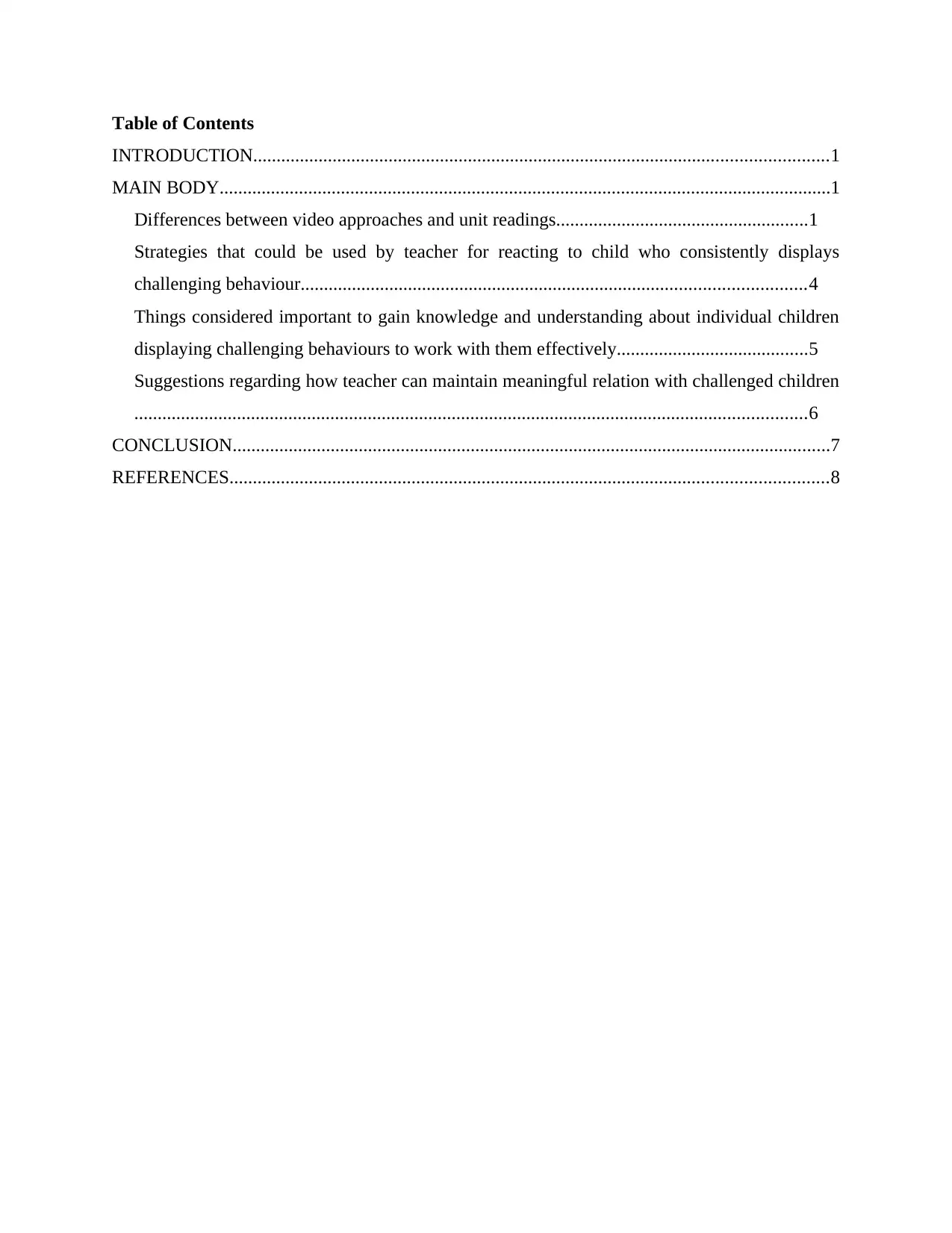
Table of Contents
INTRODUCTION...........................................................................................................................1
MAIN BODY...................................................................................................................................1
Differences between video approaches and unit readings......................................................1
Strategies that could be used by teacher for reacting to child who consistently displays
challenging behaviour............................................................................................................4
Things considered important to gain knowledge and understanding about individual children
displaying challenging behaviours to work with them effectively.........................................5
Suggestions regarding how teacher can maintain meaningful relation with challenged children
................................................................................................................................................6
CONCLUSION................................................................................................................................7
REFERENCES................................................................................................................................8
INTRODUCTION...........................................................................................................................1
MAIN BODY...................................................................................................................................1
Differences between video approaches and unit readings......................................................1
Strategies that could be used by teacher for reacting to child who consistently displays
challenging behaviour............................................................................................................4
Things considered important to gain knowledge and understanding about individual children
displaying challenging behaviours to work with them effectively.........................................5
Suggestions regarding how teacher can maintain meaningful relation with challenged children
................................................................................................................................................6
CONCLUSION................................................................................................................................7
REFERENCES................................................................................................................................8
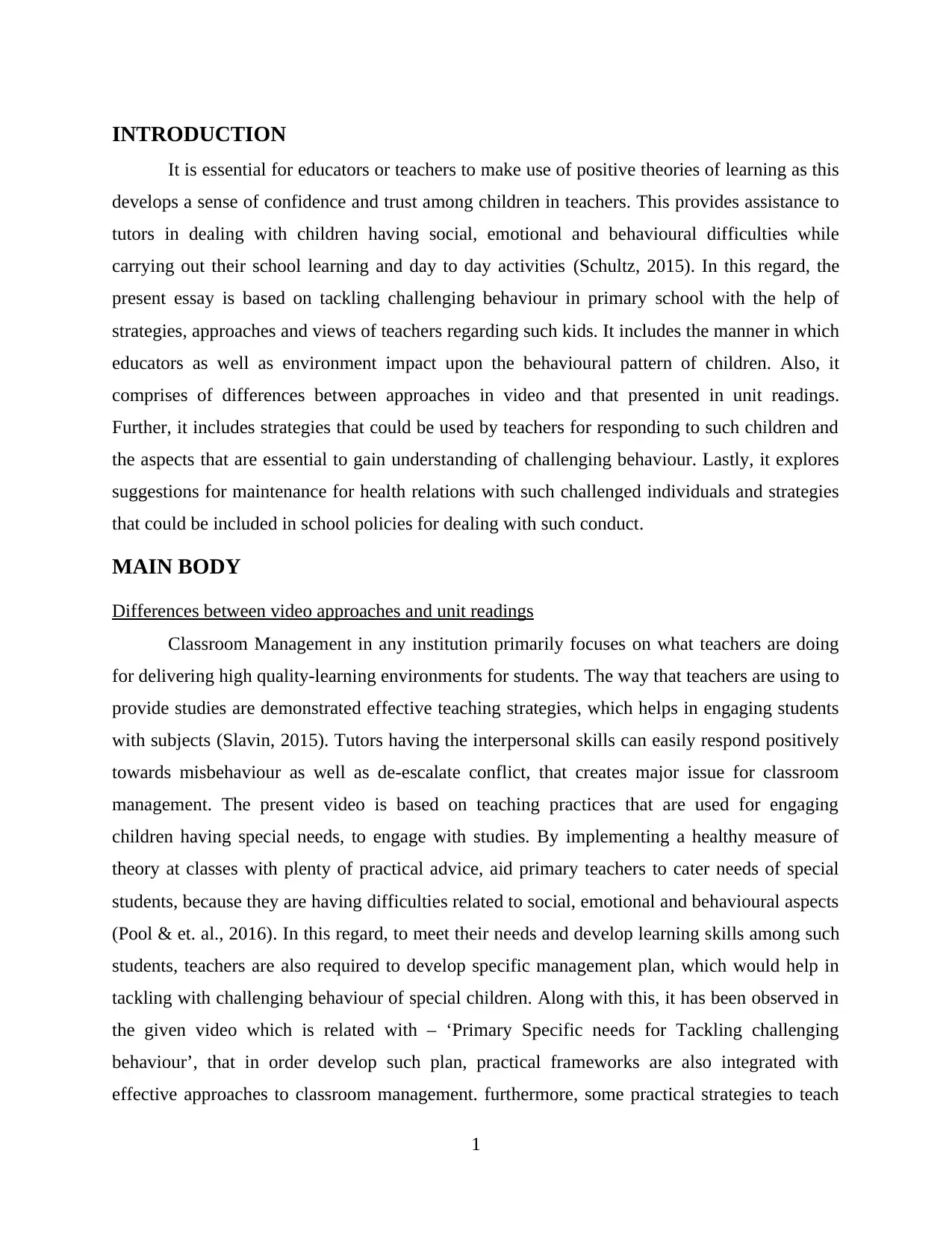
INTRODUCTION
It is essential for educators or teachers to make use of positive theories of learning as this
develops a sense of confidence and trust among children in teachers. This provides assistance to
tutors in dealing with children having social, emotional and behavioural difficulties while
carrying out their school learning and day to day activities (Schultz, 2015). In this regard, the
present essay is based on tackling challenging behaviour in primary school with the help of
strategies, approaches and views of teachers regarding such kids. It includes the manner in which
educators as well as environment impact upon the behavioural pattern of children. Also, it
comprises of differences between approaches in video and that presented in unit readings.
Further, it includes strategies that could be used by teachers for responding to such children and
the aspects that are essential to gain understanding of challenging behaviour. Lastly, it explores
suggestions for maintenance for health relations with such challenged individuals and strategies
that could be included in school policies for dealing with such conduct.
MAIN BODY
Differences between video approaches and unit readings
Classroom Management in any institution primarily focuses on what teachers are doing
for delivering high quality-learning environments for students. The way that teachers are using to
provide studies are demonstrated effective teaching strategies, which helps in engaging students
with subjects (Slavin, 2015). Tutors having the interpersonal skills can easily respond positively
towards misbehaviour as well as de-escalate conflict, that creates major issue for classroom
management. The present video is based on teaching practices that are used for engaging
children having special needs, to engage with studies. By implementing a healthy measure of
theory at classes with plenty of practical advice, aid primary teachers to cater needs of special
students, because they are having difficulties related to social, emotional and behavioural aspects
(Pool & et. al., 2016). In this regard, to meet their needs and develop learning skills among such
students, teachers are also required to develop specific management plan, which would help in
tackling with challenging behaviour of special children. Along with this, it has been observed in
the given video which is related with – ‘Primary Specific needs for Tackling challenging
behaviour’, that in order develop such plan, practical frameworks are also integrated with
effective approaches to classroom management. furthermore, some practical strategies to teach
1
It is essential for educators or teachers to make use of positive theories of learning as this
develops a sense of confidence and trust among children in teachers. This provides assistance to
tutors in dealing with children having social, emotional and behavioural difficulties while
carrying out their school learning and day to day activities (Schultz, 2015). In this regard, the
present essay is based on tackling challenging behaviour in primary school with the help of
strategies, approaches and views of teachers regarding such kids. It includes the manner in which
educators as well as environment impact upon the behavioural pattern of children. Also, it
comprises of differences between approaches in video and that presented in unit readings.
Further, it includes strategies that could be used by teachers for responding to such children and
the aspects that are essential to gain understanding of challenging behaviour. Lastly, it explores
suggestions for maintenance for health relations with such challenged individuals and strategies
that could be included in school policies for dealing with such conduct.
MAIN BODY
Differences between video approaches and unit readings
Classroom Management in any institution primarily focuses on what teachers are doing
for delivering high quality-learning environments for students. The way that teachers are using to
provide studies are demonstrated effective teaching strategies, which helps in engaging students
with subjects (Slavin, 2015). Tutors having the interpersonal skills can easily respond positively
towards misbehaviour as well as de-escalate conflict, that creates major issue for classroom
management. The present video is based on teaching practices that are used for engaging
children having special needs, to engage with studies. By implementing a healthy measure of
theory at classes with plenty of practical advice, aid primary teachers to cater needs of special
students, because they are having difficulties related to social, emotional and behavioural aspects
(Pool & et. al., 2016). In this regard, to meet their needs and develop learning skills among such
students, teachers are also required to develop specific management plan, which would help in
tackling with challenging behaviour of special children. Along with this, it has been observed in
the given video which is related with – ‘Primary Specific needs for Tackling challenging
behaviour’, that in order develop such plan, practical frameworks are also integrated with
effective approaches to classroom management. furthermore, some practical strategies to teach
1
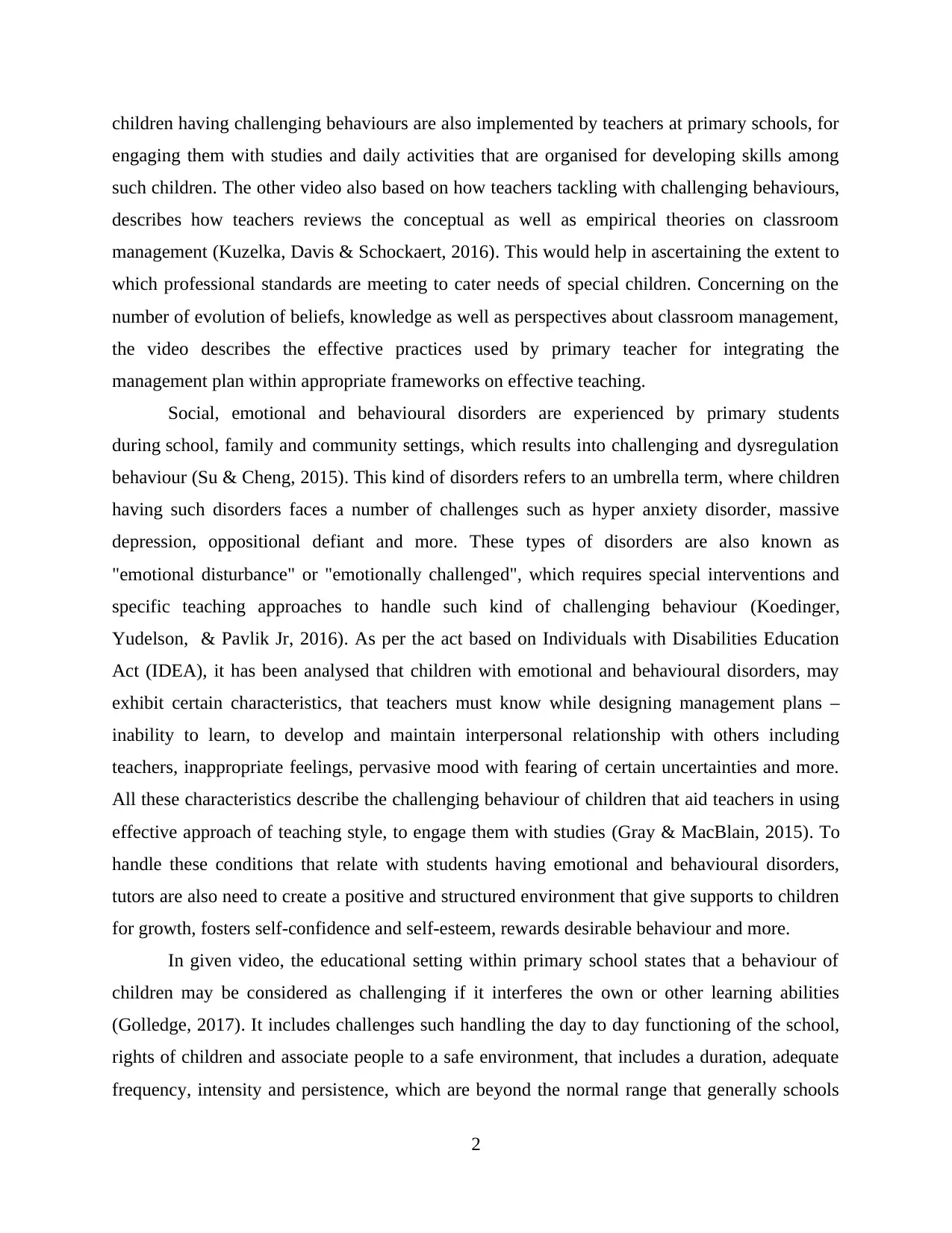
children having challenging behaviours are also implemented by teachers at primary schools, for
engaging them with studies and daily activities that are organised for developing skills among
such children. The other video also based on how teachers tackling with challenging behaviours,
describes how teachers reviews the conceptual as well as empirical theories on classroom
management (Kuzelka, Davis & Schockaert, 2016). This would help in ascertaining the extent to
which professional standards are meeting to cater needs of special children. Concerning on the
number of evolution of beliefs, knowledge as well as perspectives about classroom management,
the video describes the effective practices used by primary teacher for integrating the
management plan within appropriate frameworks on effective teaching.
Social, emotional and behavioural disorders are experienced by primary students
during school, family and community settings, which results into challenging and dysregulation
behaviour (Su & Cheng, 2015). This kind of disorders refers to an umbrella term, where children
having such disorders faces a number of challenges such as hyper anxiety disorder, massive
depression, oppositional defiant and more. These types of disorders are also known as
"emotional disturbance" or "emotionally challenged", which requires special interventions and
specific teaching approaches to handle such kind of challenging behaviour (Koedinger,
Yudelson, & Pavlik Jr, 2016). As per the act based on Individuals with Disabilities Education
Act (IDEA), it has been analysed that children with emotional and behavioural disorders, may
exhibit certain characteristics, that teachers must know while designing management plans –
inability to learn, to develop and maintain interpersonal relationship with others including
teachers, inappropriate feelings, pervasive mood with fearing of certain uncertainties and more.
All these characteristics describe the challenging behaviour of children that aid teachers in using
effective approach of teaching style, to engage them with studies (Gray & MacBlain, 2015). To
handle these conditions that relate with students having emotional and behavioural disorders,
tutors are also need to create a positive and structured environment that give supports to children
for growth, fosters self-confidence and self-esteem, rewards desirable behaviour and more.
In given video, the educational setting within primary school states that a behaviour of
children may be considered as challenging if it interferes the own or other learning abilities
(Golledge, 2017). It includes challenges such handling the day to day functioning of the school,
rights of children and associate people to a safe environment, that includes a duration, adequate
frequency, intensity and persistence, which are beyond the normal range that generally schools
2
engaging them with studies and daily activities that are organised for developing skills among
such children. The other video also based on how teachers tackling with challenging behaviours,
describes how teachers reviews the conceptual as well as empirical theories on classroom
management (Kuzelka, Davis & Schockaert, 2016). This would help in ascertaining the extent to
which professional standards are meeting to cater needs of special children. Concerning on the
number of evolution of beliefs, knowledge as well as perspectives about classroom management,
the video describes the effective practices used by primary teacher for integrating the
management plan within appropriate frameworks on effective teaching.
Social, emotional and behavioural disorders are experienced by primary students
during school, family and community settings, which results into challenging and dysregulation
behaviour (Su & Cheng, 2015). This kind of disorders refers to an umbrella term, where children
having such disorders faces a number of challenges such as hyper anxiety disorder, massive
depression, oppositional defiant and more. These types of disorders are also known as
"emotional disturbance" or "emotionally challenged", which requires special interventions and
specific teaching approaches to handle such kind of challenging behaviour (Koedinger,
Yudelson, & Pavlik Jr, 2016). As per the act based on Individuals with Disabilities Education
Act (IDEA), it has been analysed that children with emotional and behavioural disorders, may
exhibit certain characteristics, that teachers must know while designing management plans –
inability to learn, to develop and maintain interpersonal relationship with others including
teachers, inappropriate feelings, pervasive mood with fearing of certain uncertainties and more.
All these characteristics describe the challenging behaviour of children that aid teachers in using
effective approach of teaching style, to engage them with studies (Gray & MacBlain, 2015). To
handle these conditions that relate with students having emotional and behavioural disorders,
tutors are also need to create a positive and structured environment that give supports to children
for growth, fosters self-confidence and self-esteem, rewards desirable behaviour and more.
In given video, the educational setting within primary school states that a behaviour of
children may be considered as challenging if it interferes the own or other learning abilities
(Golledge, 2017). It includes challenges such handling the day to day functioning of the school,
rights of children and associate people to a safe environment, that includes a duration, adequate
frequency, intensity and persistence, which are beyond the normal range that generally schools
2
Secure Best Marks with AI Grader
Need help grading? Try our AI Grader for instant feedback on your assignments.
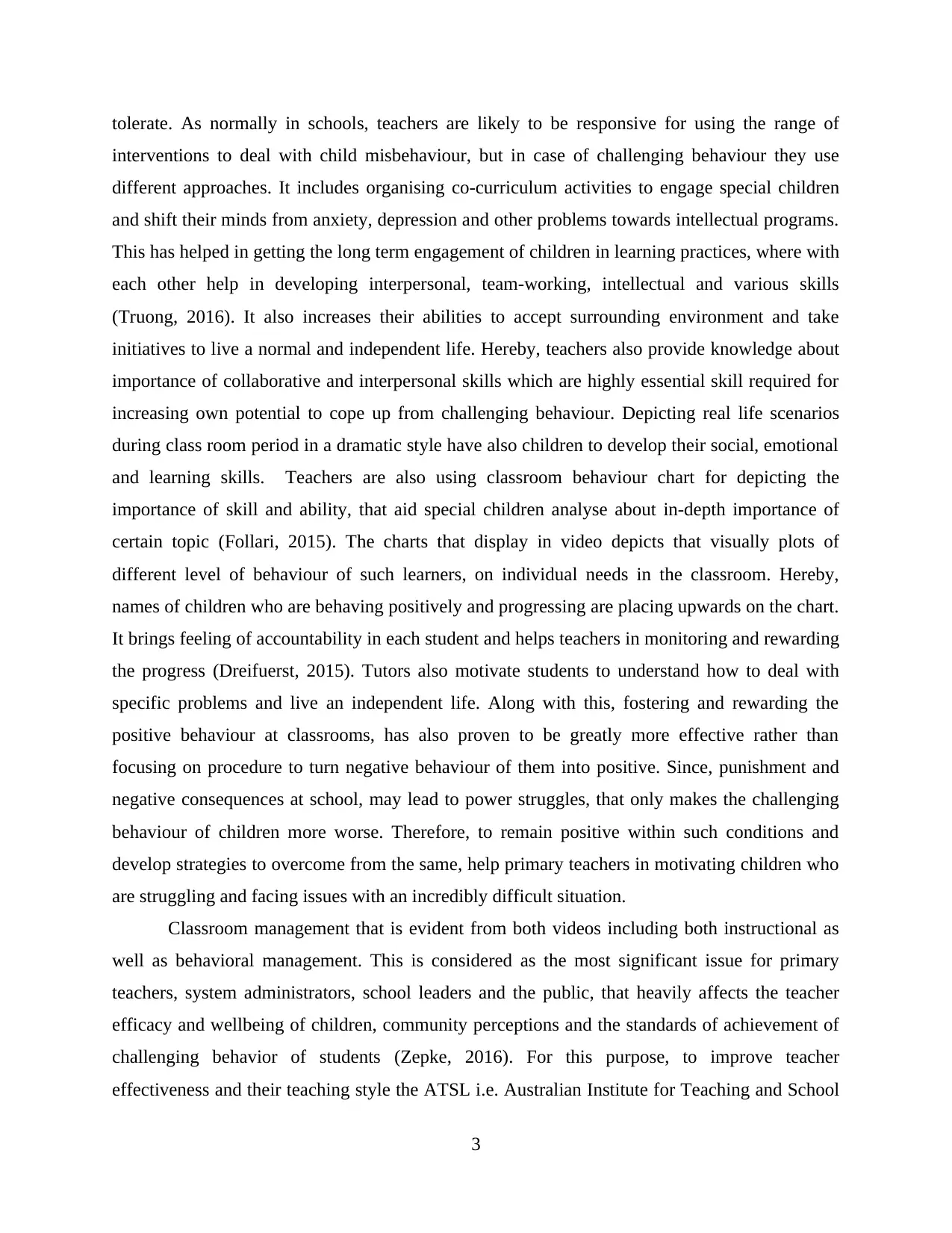
tolerate. As normally in schools, teachers are likely to be responsive for using the range of
interventions to deal with child misbehaviour, but in case of challenging behaviour they use
different approaches. It includes organising co-curriculum activities to engage special children
and shift their minds from anxiety, depression and other problems towards intellectual programs.
This has helped in getting the long term engagement of children in learning practices, where with
each other help in developing interpersonal, team-working, intellectual and various skills
(Truong, 2016). It also increases their abilities to accept surrounding environment and take
initiatives to live a normal and independent life. Hereby, teachers also provide knowledge about
importance of collaborative and interpersonal skills which are highly essential skill required for
increasing own potential to cope up from challenging behaviour. Depicting real life scenarios
during class room period in a dramatic style have also children to develop their social, emotional
and learning skills. Teachers are also using classroom behaviour chart for depicting the
importance of skill and ability, that aid special children analyse about in-depth importance of
certain topic (Follari, 2015). The charts that display in video depicts that visually plots of
different level of behaviour of such learners, on individual needs in the classroom. Hereby,
names of children who are behaving positively and progressing are placing upwards on the chart.
It brings feeling of accountability in each student and helps teachers in monitoring and rewarding
the progress (Dreifuerst, 2015). Tutors also motivate students to understand how to deal with
specific problems and live an independent life. Along with this, fostering and rewarding the
positive behaviour at classrooms, has also proven to be greatly more effective rather than
focusing on procedure to turn negative behaviour of them into positive. Since, punishment and
negative consequences at school, may lead to power struggles, that only makes the challenging
behaviour of children more worse. Therefore, to remain positive within such conditions and
develop strategies to overcome from the same, help primary teachers in motivating children who
are struggling and facing issues with an incredibly difficult situation.
Classroom management that is evident from both videos including both instructional as
well as behavioral management. This is considered as the most significant issue for primary
teachers, system administrators, school leaders and the public, that heavily affects the teacher
efficacy and wellbeing of children, community perceptions and the standards of achievement of
challenging behavior of students (Zepke, 2016). For this purpose, to improve teacher
effectiveness and their teaching style the ATSL i.e. Australian Institute for Teaching and School
3
interventions to deal with child misbehaviour, but in case of challenging behaviour they use
different approaches. It includes organising co-curriculum activities to engage special children
and shift their minds from anxiety, depression and other problems towards intellectual programs.
This has helped in getting the long term engagement of children in learning practices, where with
each other help in developing interpersonal, team-working, intellectual and various skills
(Truong, 2016). It also increases their abilities to accept surrounding environment and take
initiatives to live a normal and independent life. Hereby, teachers also provide knowledge about
importance of collaborative and interpersonal skills which are highly essential skill required for
increasing own potential to cope up from challenging behaviour. Depicting real life scenarios
during class room period in a dramatic style have also children to develop their social, emotional
and learning skills. Teachers are also using classroom behaviour chart for depicting the
importance of skill and ability, that aid special children analyse about in-depth importance of
certain topic (Follari, 2015). The charts that display in video depicts that visually plots of
different level of behaviour of such learners, on individual needs in the classroom. Hereby,
names of children who are behaving positively and progressing are placing upwards on the chart.
It brings feeling of accountability in each student and helps teachers in monitoring and rewarding
the progress (Dreifuerst, 2015). Tutors also motivate students to understand how to deal with
specific problems and live an independent life. Along with this, fostering and rewarding the
positive behaviour at classrooms, has also proven to be greatly more effective rather than
focusing on procedure to turn negative behaviour of them into positive. Since, punishment and
negative consequences at school, may lead to power struggles, that only makes the challenging
behaviour of children more worse. Therefore, to remain positive within such conditions and
develop strategies to overcome from the same, help primary teachers in motivating children who
are struggling and facing issues with an incredibly difficult situation.
Classroom management that is evident from both videos including both instructional as
well as behavioral management. This is considered as the most significant issue for primary
teachers, system administrators, school leaders and the public, that heavily affects the teacher
efficacy and wellbeing of children, community perceptions and the standards of achievement of
challenging behavior of students (Zepke, 2016). For this purpose, to improve teacher
effectiveness and their teaching style the ATSL i.e. Australian Institute for Teaching and School
3
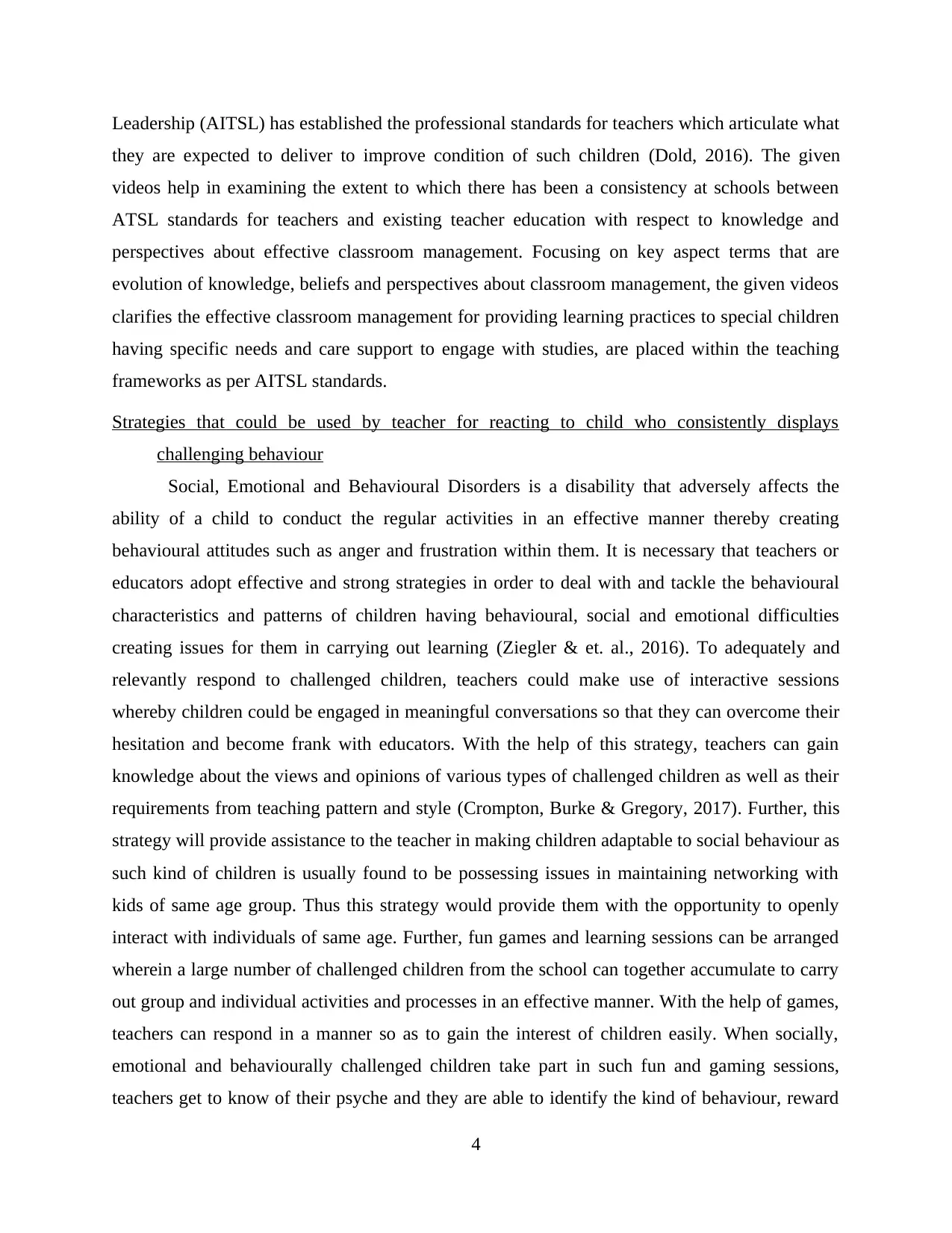
Leadership (AITSL) has established the professional standards for teachers which articulate what
they are expected to deliver to improve condition of such children (Dold, 2016). The given
videos help in examining the extent to which there has been a consistency at schools between
ATSL standards for teachers and existing teacher education with respect to knowledge and
perspectives about effective classroom management. Focusing on key aspect terms that are
evolution of knowledge, beliefs and perspectives about classroom management, the given videos
clarifies the effective classroom management for providing learning practices to special children
having specific needs and care support to engage with studies, are placed within the teaching
frameworks as per AITSL standards.
Strategies that could be used by teacher for reacting to child who consistently displays
challenging behaviour
Social, Emotional and Behavioural Disorders is a disability that adversely affects the
ability of a child to conduct the regular activities in an effective manner thereby creating
behavioural attitudes such as anger and frustration within them. It is necessary that teachers or
educators adopt effective and strong strategies in order to deal with and tackle the behavioural
characteristics and patterns of children having behavioural, social and emotional difficulties
creating issues for them in carrying out learning (Ziegler & et. al., 2016). To adequately and
relevantly respond to challenged children, teachers could make use of interactive sessions
whereby children could be engaged in meaningful conversations so that they can overcome their
hesitation and become frank with educators. With the help of this strategy, teachers can gain
knowledge about the views and opinions of various types of challenged children as well as their
requirements from teaching pattern and style (Crompton, Burke & Gregory, 2017). Further, this
strategy will provide assistance to the teacher in making children adaptable to social behaviour as
such kind of children is usually found to be possessing issues in maintaining networking with
kids of same age group. Thus this strategy would provide them with the opportunity to openly
interact with individuals of same age. Further, fun games and learning sessions can be arranged
wherein a large number of challenged children from the school can together accumulate to carry
out group and individual activities and processes in an effective manner. With the help of games,
teachers can respond in a manner so as to gain the interest of children easily. When socially,
emotional and behaviourally challenged children take part in such fun and gaming sessions,
teachers get to know of their psyche and they are able to identify the kind of behaviour, reward
4
they are expected to deliver to improve condition of such children (Dold, 2016). The given
videos help in examining the extent to which there has been a consistency at schools between
ATSL standards for teachers and existing teacher education with respect to knowledge and
perspectives about effective classroom management. Focusing on key aspect terms that are
evolution of knowledge, beliefs and perspectives about classroom management, the given videos
clarifies the effective classroom management for providing learning practices to special children
having specific needs and care support to engage with studies, are placed within the teaching
frameworks as per AITSL standards.
Strategies that could be used by teacher for reacting to child who consistently displays
challenging behaviour
Social, Emotional and Behavioural Disorders is a disability that adversely affects the
ability of a child to conduct the regular activities in an effective manner thereby creating
behavioural attitudes such as anger and frustration within them. It is necessary that teachers or
educators adopt effective and strong strategies in order to deal with and tackle the behavioural
characteristics and patterns of children having behavioural, social and emotional difficulties
creating issues for them in carrying out learning (Ziegler & et. al., 2016). To adequately and
relevantly respond to challenged children, teachers could make use of interactive sessions
whereby children could be engaged in meaningful conversations so that they can overcome their
hesitation and become frank with educators. With the help of this strategy, teachers can gain
knowledge about the views and opinions of various types of challenged children as well as their
requirements from teaching pattern and style (Crompton, Burke & Gregory, 2017). Further, this
strategy will provide assistance to the teacher in making children adaptable to social behaviour as
such kind of children is usually found to be possessing issues in maintaining networking with
kids of same age group. Thus this strategy would provide them with the opportunity to openly
interact with individuals of same age. Further, fun games and learning sessions can be arranged
wherein a large number of challenged children from the school can together accumulate to carry
out group and individual activities and processes in an effective manner. With the help of games,
teachers can respond in a manner so as to gain the interest of children easily. When socially,
emotional and behaviourally challenged children take part in such fun and gaming sessions,
teachers get to know of their psyche and they are able to identify the kind of behaviour, reward
4

or punishment, attracts the particular child individually (Cano-De-La-Cuerda & et. al., 2015).
This helps them in reacting to the children on the basis of their likelihood and behavioural
patterns. Further, there are many other kinds of group activities which are arranged by teachers
in primary school for challenged people so that they can learn by way of fun, interaction and
activity. With the help of these strategies, teachers get the knowledge regarding how to react
effectively to the children who are victim to Social, Emotional and Behavioural difficulties.
Things considered important to gain knowledge and understanding about individual children
displaying challenging behaviours to work with them effectively
Dealing with children having social, emotional and behavioural disorders is not at all an
easy task. Such individuals are in constant requirement of well structured and positive
environment that has the capability to aid the growth, enhance self esteem and confidence and
reward desirable behavioural pattern (Blake, 2015). Thus, below mentioned are some strategies
by way of which knowledge can be gained about the children depicting challenging behavioural
pattern:-
There should be strict rules and routines regarding the behavioural conduct and pattern of
challenged children as these make things understandable as well as simple. Further, the
adversities of breaking such kinds of rules within the Australian Curriculum must also be
stipulated at the initiation of year and strictly implemented in the premises. When a rule is
breached and students are confronted upon that, their behaviour should be noted in order to
analyse their behavioural tendency and to decide upon strategies through which learning can be
facilitated irrespective of the disorder (Bilgin, Karakuyu & Ay, 2015). Teachers should try to
avoid any type of emotional reaction when rules are broken as this renders students negative
attention, which many children find very rewarding. Being firm yet remaining kind is the key to
effectively tackling such behaviours. It’s difficult to maintain a balance yet this serves as the
base for positive results. This is because routines are significant for classroom discipline and
management. Students having emotional, social and behavioural disorder tend to struggle with
transition as well as any kind of unexpected changes.
Students with emotional and behavioural disorders often need to receive instruction in a
special education setting as their behavioural pattern is found to be too maladaptive for a general
education classroom. In this regard, such students should be asked to watch their peers who are
adequately and relevantly carrying out learning and then identify positive behaviours to adapt the
5
This helps them in reacting to the children on the basis of their likelihood and behavioural
patterns. Further, there are many other kinds of group activities which are arranged by teachers
in primary school for challenged people so that they can learn by way of fun, interaction and
activity. With the help of these strategies, teachers get the knowledge regarding how to react
effectively to the children who are victim to Social, Emotional and Behavioural difficulties.
Things considered important to gain knowledge and understanding about individual children
displaying challenging behaviours to work with them effectively
Dealing with children having social, emotional and behavioural disorders is not at all an
easy task. Such individuals are in constant requirement of well structured and positive
environment that has the capability to aid the growth, enhance self esteem and confidence and
reward desirable behavioural pattern (Blake, 2015). Thus, below mentioned are some strategies
by way of which knowledge can be gained about the children depicting challenging behavioural
pattern:-
There should be strict rules and routines regarding the behavioural conduct and pattern of
challenged children as these make things understandable as well as simple. Further, the
adversities of breaking such kinds of rules within the Australian Curriculum must also be
stipulated at the initiation of year and strictly implemented in the premises. When a rule is
breached and students are confronted upon that, their behaviour should be noted in order to
analyse their behavioural tendency and to decide upon strategies through which learning can be
facilitated irrespective of the disorder (Bilgin, Karakuyu & Ay, 2015). Teachers should try to
avoid any type of emotional reaction when rules are broken as this renders students negative
attention, which many children find very rewarding. Being firm yet remaining kind is the key to
effectively tackling such behaviours. It’s difficult to maintain a balance yet this serves as the
base for positive results. This is because routines are significant for classroom discipline and
management. Students having emotional, social and behavioural disorder tend to struggle with
transition as well as any kind of unexpected changes.
Students with emotional and behavioural disorders often need to receive instruction in a
special education setting as their behavioural pattern is found to be too maladaptive for a general
education classroom. In this regard, such students should be asked to watch their peers who are
adequately and relevantly carrying out learning and then identify positive behaviours to adapt the
5
Paraphrase This Document
Need a fresh take? Get an instant paraphrase of this document with our AI Paraphraser
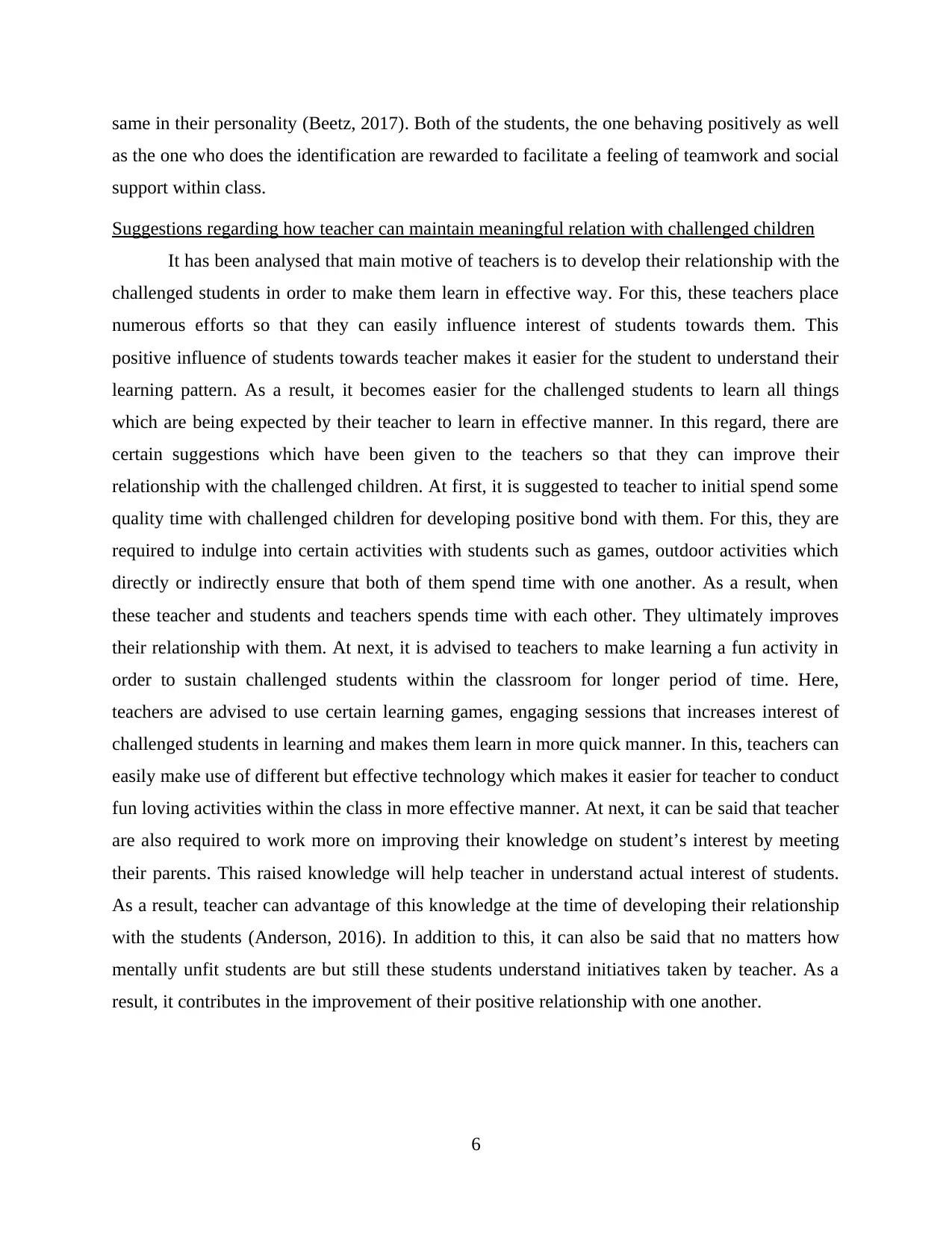
same in their personality (Beetz, 2017). Both of the students, the one behaving positively as well
as the one who does the identification are rewarded to facilitate a feeling of teamwork and social
support within class.
Suggestions regarding how teacher can maintain meaningful relation with challenged children
It has been analysed that main motive of teachers is to develop their relationship with the
challenged students in order to make them learn in effective way. For this, these teachers place
numerous efforts so that they can easily influence interest of students towards them. This
positive influence of students towards teacher makes it easier for the student to understand their
learning pattern. As a result, it becomes easier for the challenged students to learn all things
which are being expected by their teacher to learn in effective manner. In this regard, there are
certain suggestions which have been given to the teachers so that they can improve their
relationship with the challenged children. At first, it is suggested to teacher to initial spend some
quality time with challenged children for developing positive bond with them. For this, they are
required to indulge into certain activities with students such as games, outdoor activities which
directly or indirectly ensure that both of them spend time with one another. As a result, when
these teacher and students and teachers spends time with each other. They ultimately improves
their relationship with them. At next, it is advised to teachers to make learning a fun activity in
order to sustain challenged students within the classroom for longer period of time. Here,
teachers are advised to use certain learning games, engaging sessions that increases interest of
challenged students in learning and makes them learn in more quick manner. In this, teachers can
easily make use of different but effective technology which makes it easier for teacher to conduct
fun loving activities within the class in more effective manner. At next, it can be said that teacher
are also required to work more on improving their knowledge on student’s interest by meeting
their parents. This raised knowledge will help teacher in understand actual interest of students.
As a result, teacher can advantage of this knowledge at the time of developing their relationship
with the students (Anderson, 2016). In addition to this, it can also be said that no matters how
mentally unfit students are but still these students understand initiatives taken by teacher. As a
result, it contributes in the improvement of their positive relationship with one another.
6
as the one who does the identification are rewarded to facilitate a feeling of teamwork and social
support within class.
Suggestions regarding how teacher can maintain meaningful relation with challenged children
It has been analysed that main motive of teachers is to develop their relationship with the
challenged students in order to make them learn in effective way. For this, these teachers place
numerous efforts so that they can easily influence interest of students towards them. This
positive influence of students towards teacher makes it easier for the student to understand their
learning pattern. As a result, it becomes easier for the challenged students to learn all things
which are being expected by their teacher to learn in effective manner. In this regard, there are
certain suggestions which have been given to the teachers so that they can improve their
relationship with the challenged children. At first, it is suggested to teacher to initial spend some
quality time with challenged children for developing positive bond with them. For this, they are
required to indulge into certain activities with students such as games, outdoor activities which
directly or indirectly ensure that both of them spend time with one another. As a result, when
these teacher and students and teachers spends time with each other. They ultimately improves
their relationship with them. At next, it is advised to teachers to make learning a fun activity in
order to sustain challenged students within the classroom for longer period of time. Here,
teachers are advised to use certain learning games, engaging sessions that increases interest of
challenged students in learning and makes them learn in more quick manner. In this, teachers can
easily make use of different but effective technology which makes it easier for teacher to conduct
fun loving activities within the class in more effective manner. At next, it can be said that teacher
are also required to work more on improving their knowledge on student’s interest by meeting
their parents. This raised knowledge will help teacher in understand actual interest of students.
As a result, teacher can advantage of this knowledge at the time of developing their relationship
with the students (Anderson, 2016). In addition to this, it can also be said that no matters how
mentally unfit students are but still these students understand initiatives taken by teacher. As a
result, it contributes in the improvement of their positive relationship with one another.
6
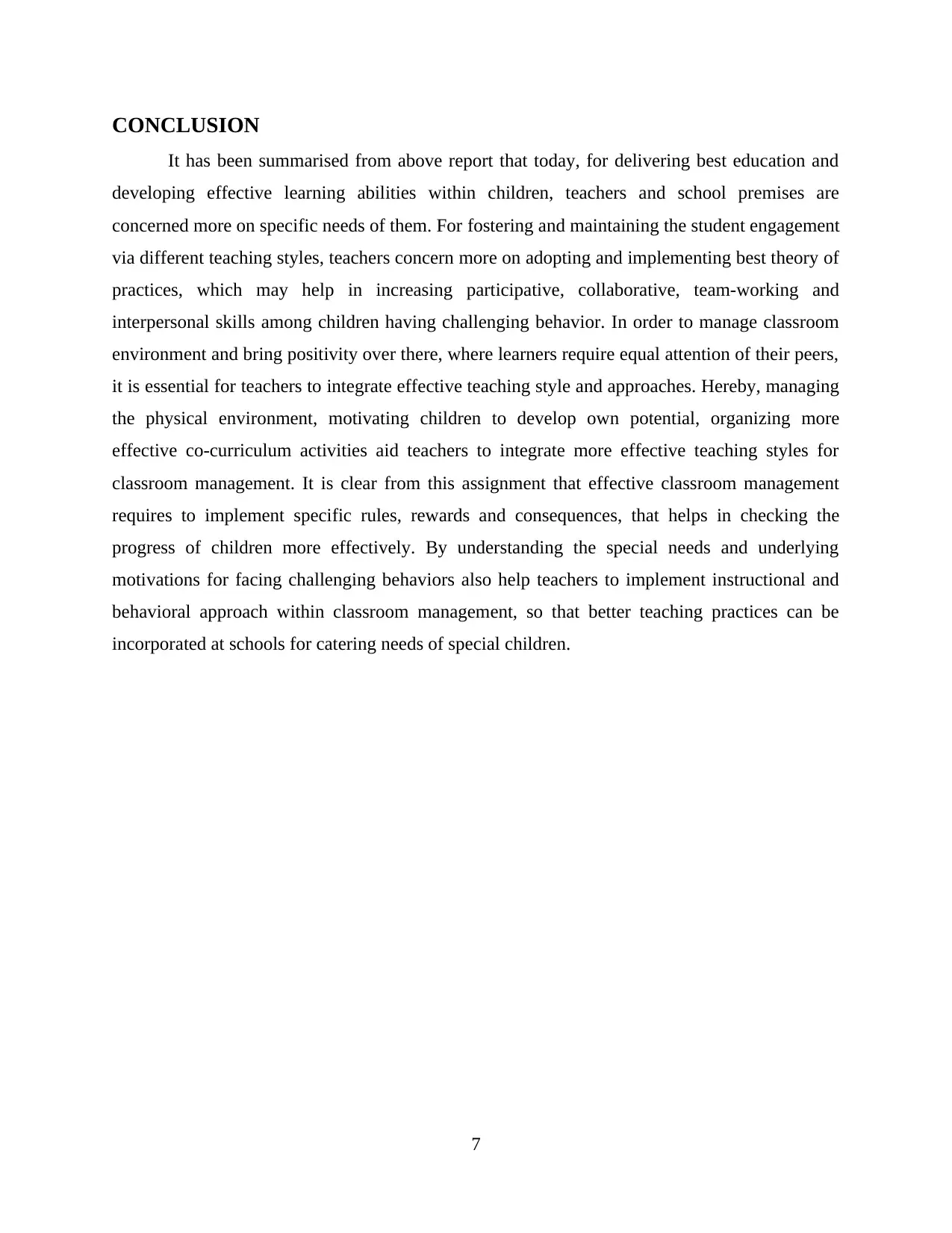
CONCLUSION
It has been summarised from above report that today, for delivering best education and
developing effective learning abilities within children, teachers and school premises are
concerned more on specific needs of them. For fostering and maintaining the student engagement
via different teaching styles, teachers concern more on adopting and implementing best theory of
practices, which may help in increasing participative, collaborative, team-working and
interpersonal skills among children having challenging behavior. In order to manage classroom
environment and bring positivity over there, where learners require equal attention of their peers,
it is essential for teachers to integrate effective teaching style and approaches. Hereby, managing
the physical environment, motivating children to develop own potential, organizing more
effective co-curriculum activities aid teachers to integrate more effective teaching styles for
classroom management. It is clear from this assignment that effective classroom management
requires to implement specific rules, rewards and consequences, that helps in checking the
progress of children more effectively. By understanding the special needs and underlying
motivations for facing challenging behaviors also help teachers to implement instructional and
behavioral approach within classroom management, so that better teaching practices can be
incorporated at schools for catering needs of special children.
7
It has been summarised from above report that today, for delivering best education and
developing effective learning abilities within children, teachers and school premises are
concerned more on specific needs of them. For fostering and maintaining the student engagement
via different teaching styles, teachers concern more on adopting and implementing best theory of
practices, which may help in increasing participative, collaborative, team-working and
interpersonal skills among children having challenging behavior. In order to manage classroom
environment and bring positivity over there, where learners require equal attention of their peers,
it is essential for teachers to integrate effective teaching style and approaches. Hereby, managing
the physical environment, motivating children to develop own potential, organizing more
effective co-curriculum activities aid teachers to integrate more effective teaching styles for
classroom management. It is clear from this assignment that effective classroom management
requires to implement specific rules, rewards and consequences, that helps in checking the
progress of children more effectively. By understanding the special needs and underlying
motivations for facing challenging behaviors also help teachers to implement instructional and
behavioral approach within classroom management, so that better teaching practices can be
incorporated at schools for catering needs of special children.
7
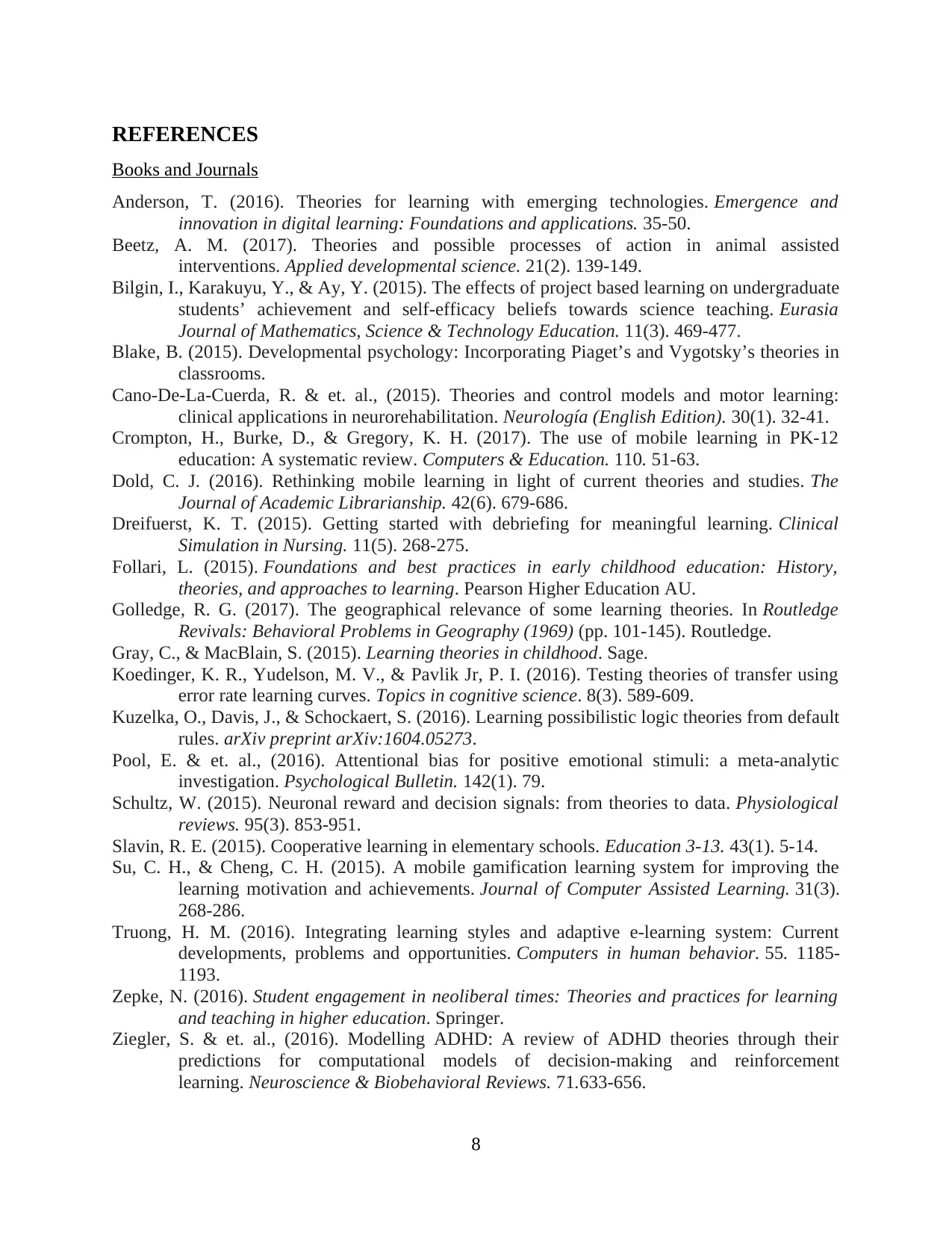
REFERENCES
Books and Journals
Anderson, T. (2016). Theories for learning with emerging technologies. Emergence and
innovation in digital learning: Foundations and applications. 35-50.
Beetz, A. M. (2017). Theories and possible processes of action in animal assisted
interventions. Applied developmental science. 21(2). 139-149.
Bilgin, I., Karakuyu, Y., & Ay, Y. (2015). The effects of project based learning on undergraduate
students’ achievement and self-efficacy beliefs towards science teaching. Eurasia
Journal of Mathematics, Science & Technology Education. 11(3). 469-477.
Blake, B. (2015). Developmental psychology: Incorporating Piaget’s and Vygotsky’s theories in
classrooms.
Cano-De-La-Cuerda, R. & et. al., (2015). Theories and control models and motor learning:
clinical applications in neurorehabilitation. Neurología (English Edition). 30(1). 32-41.
Crompton, H., Burke, D., & Gregory, K. H. (2017). The use of mobile learning in PK-12
education: A systematic review. Computers & Education. 110. 51-63.
Dold, C. J. (2016). Rethinking mobile learning in light of current theories and studies. The
Journal of Academic Librarianship. 42(6). 679-686.
Dreifuerst, K. T. (2015). Getting started with debriefing for meaningful learning. Clinical
Simulation in Nursing. 11(5). 268-275.
Follari, L. (2015). Foundations and best practices in early childhood education: History,
theories, and approaches to learning. Pearson Higher Education AU.
Golledge, R. G. (2017). The geographical relevance of some learning theories. In Routledge
Revivals: Behavioral Problems in Geography (1969) (pp. 101-145). Routledge.
Gray, C., & MacBlain, S. (2015). Learning theories in childhood. Sage.
Koedinger, K. R., Yudelson, M. V., & Pavlik Jr, P. I. (2016). Testing theories of transfer using
error rate learning curves. Topics in cognitive science. 8(3). 589-609.
Kuzelka, O., Davis, J., & Schockaert, S. (2016). Learning possibilistic logic theories from default
rules. arXiv preprint arXiv:1604.05273.
Pool, E. & et. al., (2016). Attentional bias for positive emotional stimuli: a meta-analytic
investigation. Psychological Bulletin. 142(1). 79.
Schultz, W. (2015). Neuronal reward and decision signals: from theories to data. Physiological
reviews. 95(3). 853-951.
Slavin, R. E. (2015). Cooperative learning in elementary schools. Education 3-13. 43(1). 5-14.
Su, C. H., & Cheng, C. H. (2015). A mobile gamification learning system for improving the
learning motivation and achievements. Journal of Computer Assisted Learning. 31(3).
268-286.
Truong, H. M. (2016). Integrating learning styles and adaptive e-learning system: Current
developments, problems and opportunities. Computers in human behavior. 55. 1185-
1193.
Zepke, N. (2016). Student engagement in neoliberal times: Theories and practices for learning
and teaching in higher education. Springer.
Ziegler, S. & et. al., (2016). Modelling ADHD: A review of ADHD theories through their
predictions for computational models of decision-making and reinforcement
learning. Neuroscience & Biobehavioral Reviews. 71.633-656.
8
Books and Journals
Anderson, T. (2016). Theories for learning with emerging technologies. Emergence and
innovation in digital learning: Foundations and applications. 35-50.
Beetz, A. M. (2017). Theories and possible processes of action in animal assisted
interventions. Applied developmental science. 21(2). 139-149.
Bilgin, I., Karakuyu, Y., & Ay, Y. (2015). The effects of project based learning on undergraduate
students’ achievement and self-efficacy beliefs towards science teaching. Eurasia
Journal of Mathematics, Science & Technology Education. 11(3). 469-477.
Blake, B. (2015). Developmental psychology: Incorporating Piaget’s and Vygotsky’s theories in
classrooms.
Cano-De-La-Cuerda, R. & et. al., (2015). Theories and control models and motor learning:
clinical applications in neurorehabilitation. Neurología (English Edition). 30(1). 32-41.
Crompton, H., Burke, D., & Gregory, K. H. (2017). The use of mobile learning in PK-12
education: A systematic review. Computers & Education. 110. 51-63.
Dold, C. J. (2016). Rethinking mobile learning in light of current theories and studies. The
Journal of Academic Librarianship. 42(6). 679-686.
Dreifuerst, K. T. (2015). Getting started with debriefing for meaningful learning. Clinical
Simulation in Nursing. 11(5). 268-275.
Follari, L. (2015). Foundations and best practices in early childhood education: History,
theories, and approaches to learning. Pearson Higher Education AU.
Golledge, R. G. (2017). The geographical relevance of some learning theories. In Routledge
Revivals: Behavioral Problems in Geography (1969) (pp. 101-145). Routledge.
Gray, C., & MacBlain, S. (2015). Learning theories in childhood. Sage.
Koedinger, K. R., Yudelson, M. V., & Pavlik Jr, P. I. (2016). Testing theories of transfer using
error rate learning curves. Topics in cognitive science. 8(3). 589-609.
Kuzelka, O., Davis, J., & Schockaert, S. (2016). Learning possibilistic logic theories from default
rules. arXiv preprint arXiv:1604.05273.
Pool, E. & et. al., (2016). Attentional bias for positive emotional stimuli: a meta-analytic
investigation. Psychological Bulletin. 142(1). 79.
Schultz, W. (2015). Neuronal reward and decision signals: from theories to data. Physiological
reviews. 95(3). 853-951.
Slavin, R. E. (2015). Cooperative learning in elementary schools. Education 3-13. 43(1). 5-14.
Su, C. H., & Cheng, C. H. (2015). A mobile gamification learning system for improving the
learning motivation and achievements. Journal of Computer Assisted Learning. 31(3).
268-286.
Truong, H. M. (2016). Integrating learning styles and adaptive e-learning system: Current
developments, problems and opportunities. Computers in human behavior. 55. 1185-
1193.
Zepke, N. (2016). Student engagement in neoliberal times: Theories and practices for learning
and teaching in higher education. Springer.
Ziegler, S. & et. al., (2016). Modelling ADHD: A review of ADHD theories through their
predictions for computational models of decision-making and reinforcement
learning. Neuroscience & Biobehavioral Reviews. 71.633-656.
8
1 out of 10
Related Documents
Your All-in-One AI-Powered Toolkit for Academic Success.
+13062052269
info@desklib.com
Available 24*7 on WhatsApp / Email
![[object Object]](/_next/static/media/star-bottom.7253800d.svg)
Unlock your academic potential
© 2024 | Zucol Services PVT LTD | All rights reserved.





